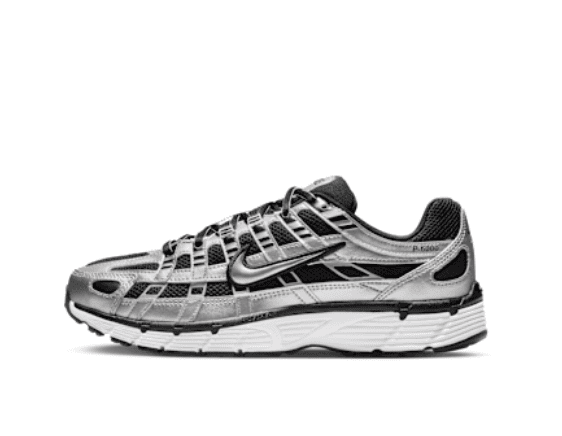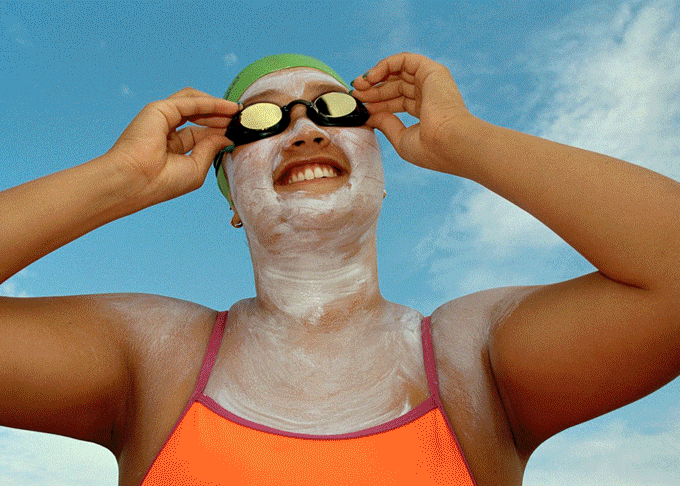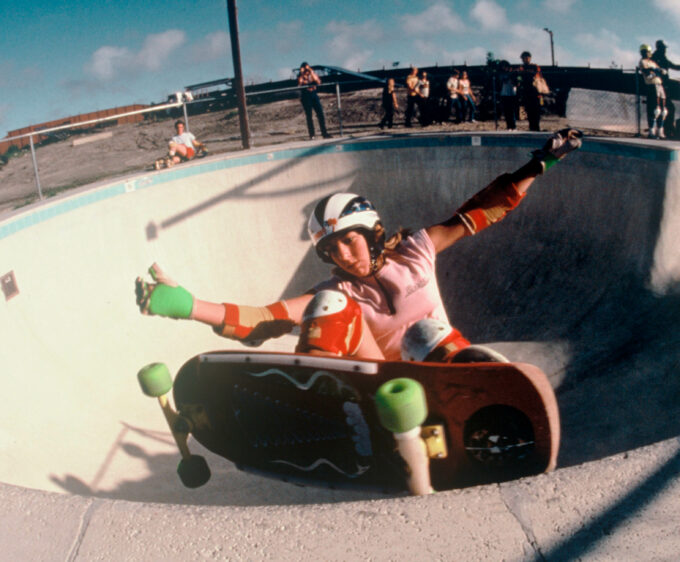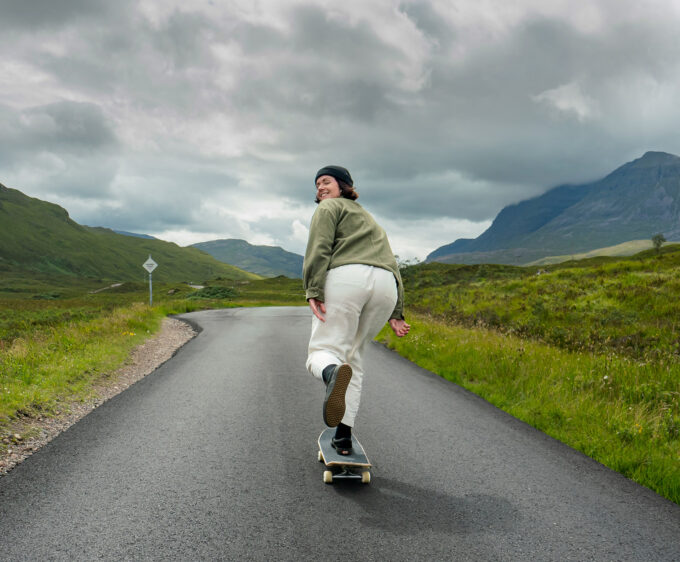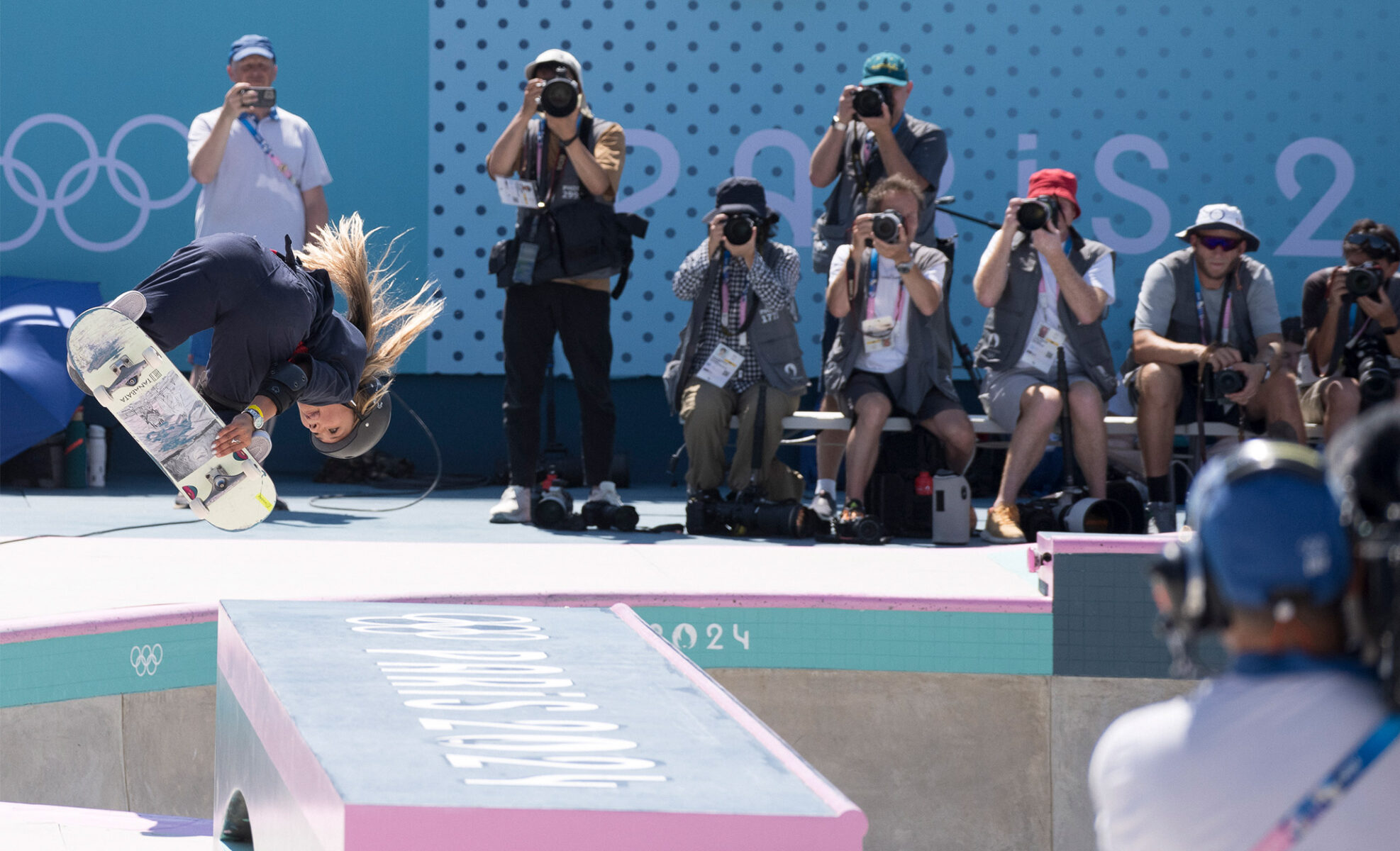
We Mind the Gap
As the Paris Olympics achieve gender equality among athletes for the first time, questions remain about equal representation in the media. Outdoor sports photographer and producer, Hannah Bailey, travelled to Paris to investigate the gender imbalance amongst sports photographers and connect with other female image-makers.
By Hannah Bailey
We have achieved a sense of parity in sports with the recent Olympics in Paris coming to a close and hailed as the first to be gender equal in terms of athletes competing. It is the first time in Olympic history that this is the case, which is startling due to the fact the Games have been running for over 3,000 years. But let’s not get carried away, if we go back only 124 years ago, it was Paris 1900 where women competed for the first time, making up only 2.2% of participants. The percentage has continued to creep up since then; from 14% at Munich 1972, 28% at Barcelona 1992, 44% at London 2012, to 50% at Paris 2024 (Source WEF). The conversation and concept of gender parity at the Games has been on the International Olympic Committee’s (IOC’s) agenda since 2012 when they mandated gender equality with competitors, ensuring future equal representation on the world’s biggest sporting stage. Regardless of the speed of change, we can celebrate it as a positive and historical moment but, as always in this world, there is still a lot of work to be done.
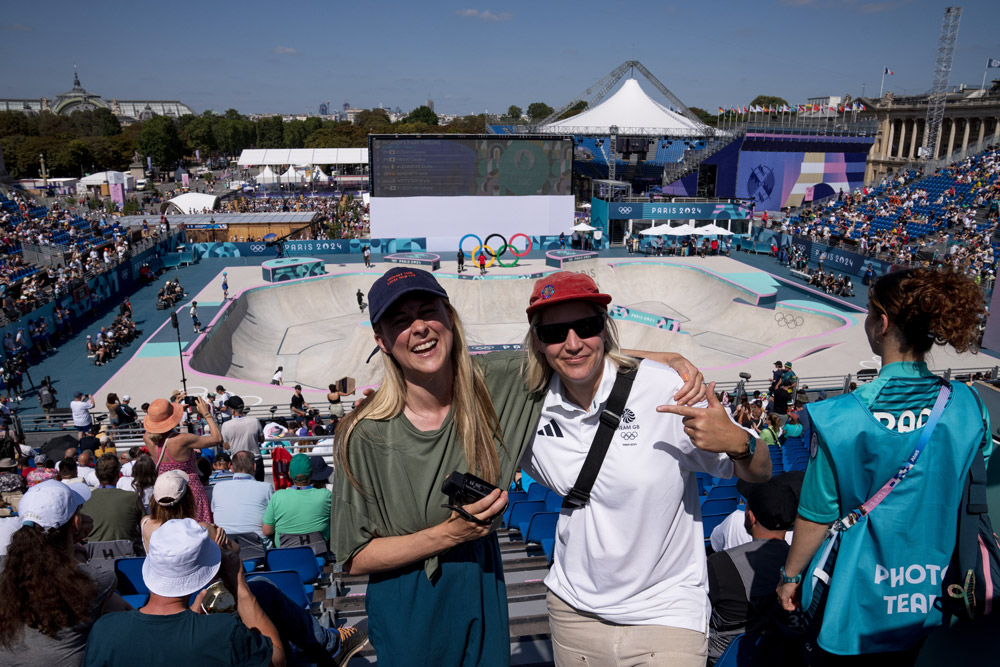
Behind the lenses (both stills and moving image) capturing these historic moments, a different picture emerges than a level gender playing field. According to the IOC, in 2021 the average percentage of accredited media personnel at the Olympic Games who are women was approximately 20%. More specifically at the Rio 2016 Olympics, only 20% of accredited photographers were women. The Tokyo 2020 Games saw a slight improvement, with women comprising 25% of the photojournalist pool. But in Beijing 2022 (the Winter Olympics) it was 12%! These statistics highlight a significant gender imbalance in accredited media. If we compare that with athlete percentages, from a photography point of view we are still stuck in Montreal 1976 (where only 20.7% of athletes were female). It indicates that on average, currently, only about one in five accredited journalists, photographers, and other media professionals covering the Olympic Games are women. For Paris, the story is the same, in fact it’s less than Tokyo. Across both the Olympics and Paralympics, I was told that 596 photographers registered to be accredited: 133 female and 463 male. That’s 22%.
Sports photography has long been dominated by men, with women’s sport fighting to get the space in the media, hence the opportunities for women in general have been fewer. We could look beyond the Olympics at general sporting events worldwide, but it is the Games that help us put the issue on the agenda and show us the scale of things. Despite incremental progress, the disparity remains stark, raising questions about representation and opportunities in sports photography in contemporary society. Why are we still this far behind?
As a sports photographer specialising in skateboarding for over 15 years, I’ve witnessed this imbalance firsthand. The addition of skateboarding in the Tokyo Olympics brought this issue into sharper focus, prompting me to investigate the representation of female photographers at the Games. I went looking for answers in the sport I know, but there are many sports and events that also do not have a balance (and also some that do!).
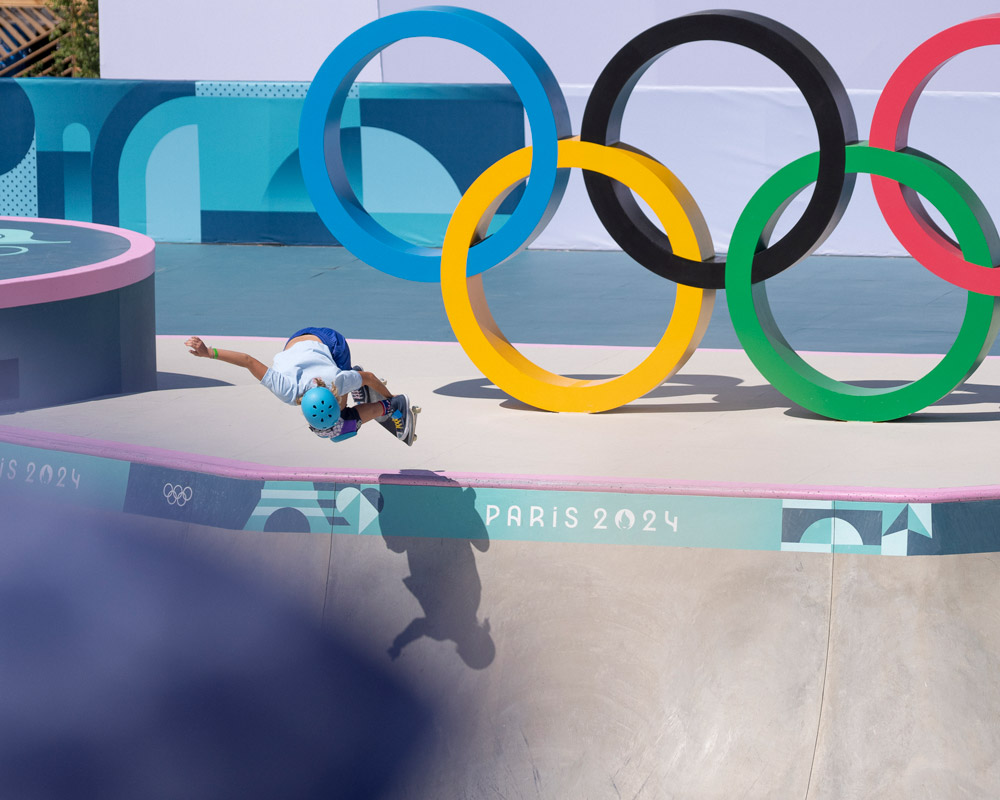
I started out photographing skateboarding in 2012. Thanks to working in the communications industry, I received an invitation from skateboarder (now Skateboard GB Progression Lead) Lucy Adams, to join a trip to Malmo, Sweden. It was curiosity and total awe that took me into the skateboarding world and I was welcomed in by skaters with my motley selection of film cameras. It was my first foray into sports photography. For me, it was about capturing a culture, people and a world I hadn’t seen in the media – and the female perspective of it. I saw my photography as a way to give these women a voice and help them be seen, but to also inspire people by the stories within it. The world of women’s skateboarding welcomed those who wanted to support and tell its worthy story. It was a small scene and underexposed. It formed its own scene, media, events and industry. And I got to be a part of it. I would follow skaters, go to events, and delve into stories of skateboarding women – then pitch them to the media determined to find ears and eyes to listen.
As I continued on this path, I finally ended up in an arena in Chicago in 2015, when women were invited to be part of Street League for the first time. It was a hint that in order for skateboarding to be on the Olympic agenda, there was a need for a qualifying series. Skateboarding finally made its official Olympic debut at the Tokyo 2020 Games, which were held in 2021 with COVID-19 restrictions limiting media and photographer attendance. The inclusion of skateboarding hoped to bring a new, younger audience to the Olympics. It also raised the profile of skateboarding globally, potentially increasing participation and investment in the sport. More than anything, it highlighted and propelled women in skateboarding – something that the world was yet to see in mass. As we know already, it caught the attention and popularity skyrocketed. We watched this historical moment from afar – women’s competitive skateboarding on the TV for the first time.

commitment
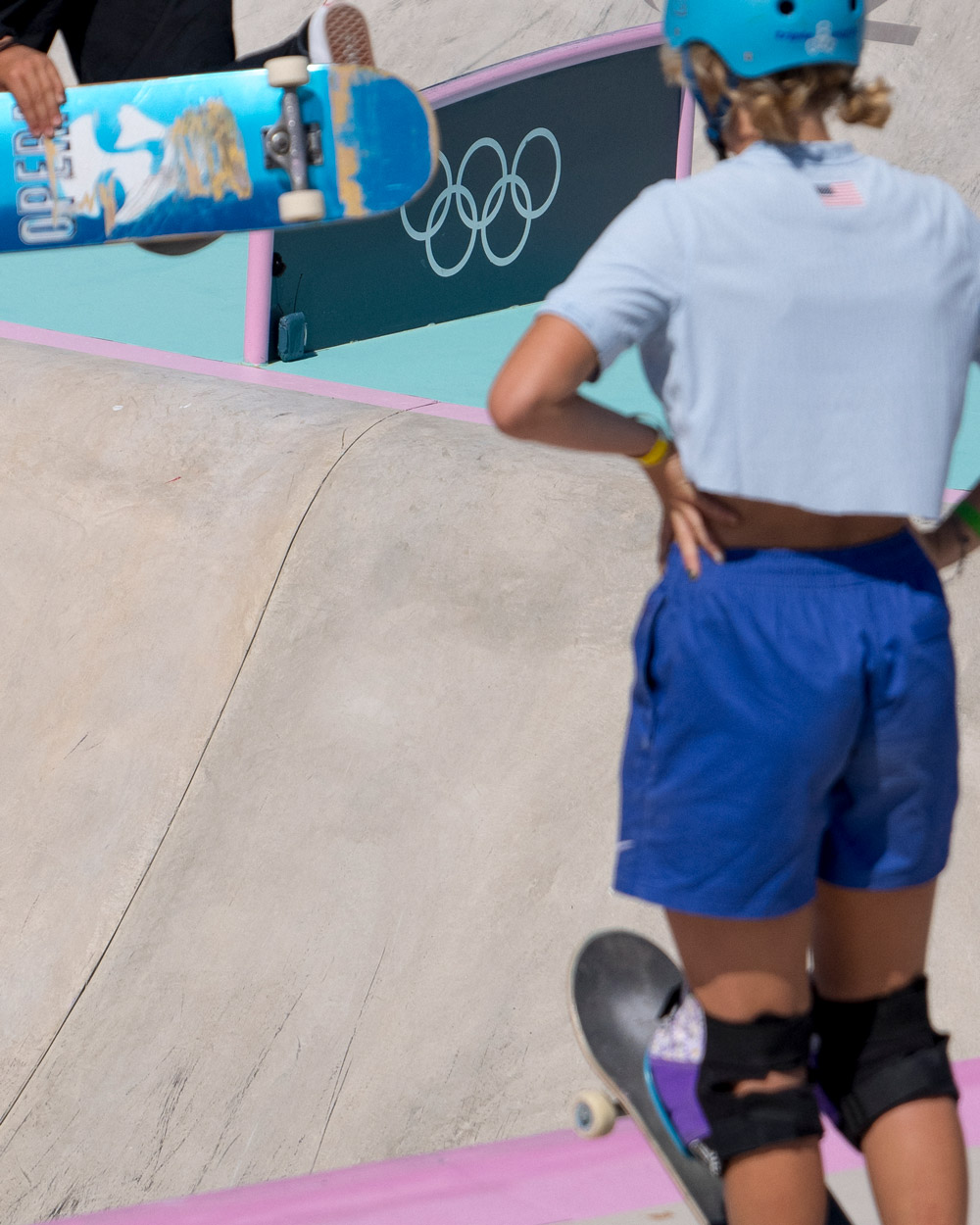
When Paris rolled around, without an invite or reason to go, I decided I wouldn’t make my own way there. Despite the sports growing popularity and media worth, it came to light that many other female skate photographers, those who had committed their time and creativity to the community for so many years, were also not “invited”. I know the commitment these women have put in to capture the scene, to give it a spotlight, to support it regardless of money or commercial interest, but fuelled by pure passion and belief. So why was Norma Ibarra not shooting the women’s comp? Or Raisa Abal, or Zorah Olivia or Alana Patterson, or Olga Aguilar, to name a few. I set off on a mission – I decided I was going to write an open letter to question this omission, but before I set off on my challenge I had to investigate, ask questions and still, attend the Games myself to see.

I reached out to the IOC, Team GB, Getty Images and World Skate to ask questions; who was going to be there capturing the skateboarding? Would you have a female skate photographer or a female sports photographer? I must admit, the replies were not all bad. I began to understand more about the system in place and the complexities to gaining accreditation for the Games – as well as understanding the challenges that have prevented female sports photographers from being represented in equal number. For example, decision-makers might unconsciously favour familiar names, which often belong to male photographers due to historical dominance. It’s already a competitive field for new photographers to break into, let alone new, female photographers to break into. This disparity is a high-profile symptom of deeper, industry-wide issues that require systemic changes to address. The IOC states that they are addressing it, but these governing bodies form part of the system and are therefore, still accountable for change.
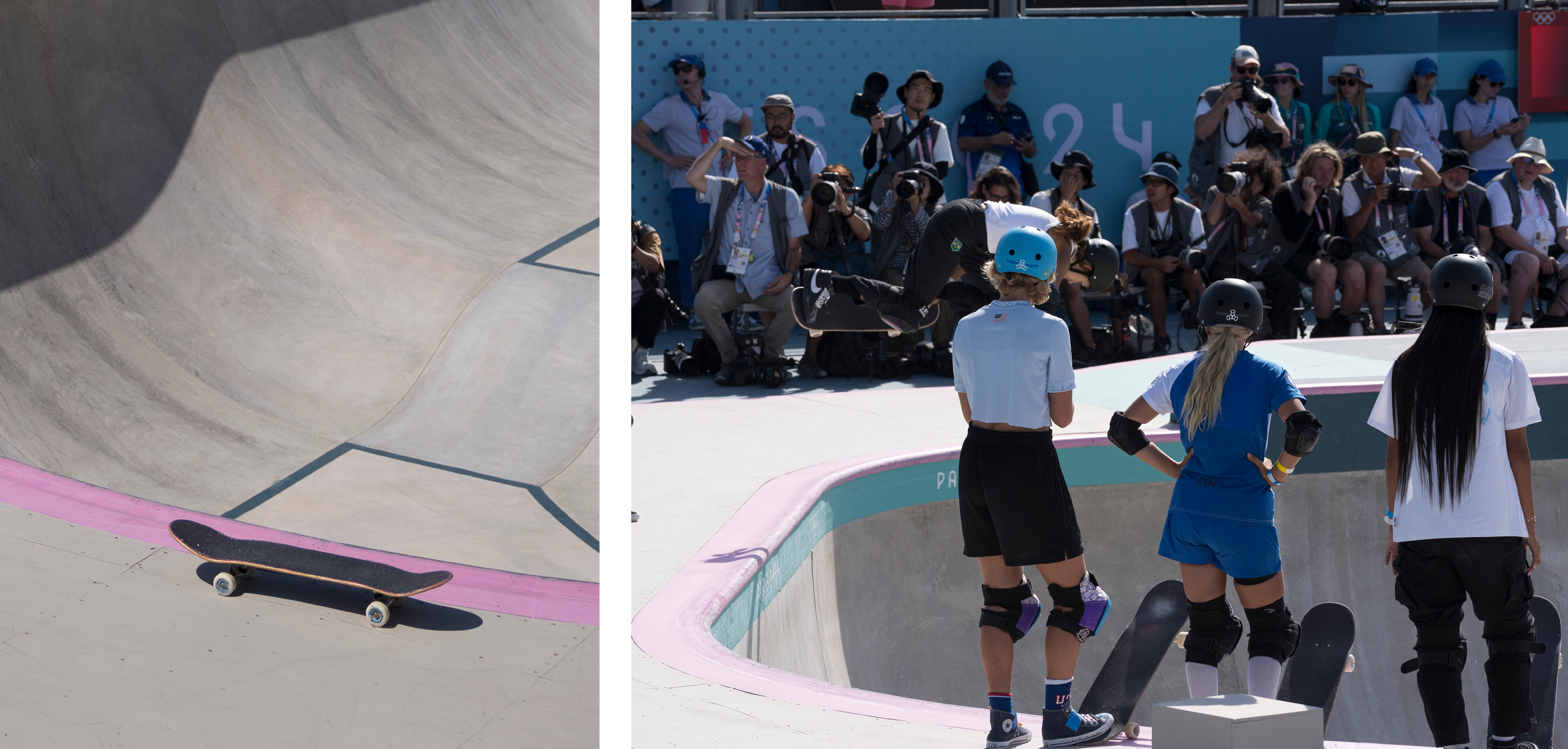
perspectives
Back to the skatepark – while specific data on female skateboarding photographers at the Olympics 2024 doesn’t yet exist, it’s reasonable to assume that their representation is likely lower than the overall 20% figure, it could be as low as 0%. From the sidelines of the skateboard park at La Place de la Concorde, I counted three women in the accreditation area, one of whom I met up the side of the stands getting a fresh angle. Sofieke Van Bilsen was there as one of the Team Deutschland photographers, the only lady on their team, but still making up 20% (one in five). It was a dream come true for her to be there. Whilst we watched the skaters carve the bowl from high up the stands, off the record we shared our woes of being taken seriously in sports photography. But Sofie is an example of the change, the women who are there bringing their skills, creativity and perspective to capturing the Olympics across an array of sports. She was shooting skateboarding for the first time, then heading off to capture the beach volleyball. Although she wasn’t a “skateboard photographer”, her being officially part of the mix provides the much-needed diversity in gender that was visually minimal, but at least present. Beyond that, many national governing bodies assured me they had also addressed this, including Team GB (one out of three) and the image mogul, Getty Images, who have an array of notable female photographers. They quickly replied to my emails to confirm they would have a female photographer on the sidelines of skateboarding, albeit not a skate-specific photographer, and that was Elsa Garrison; the first female staff photographer for Getty.
Her photography journey started when she was 14, taking photography classes at school. Many of her friends were athletic, leading her to covering sports. Elsa is now 52 years old and has been part of the Getty Images team for the Olympics since 1998. She was initially writing captions and scanning film, before her on-site photography debut as a photographer in the 2006 Winter Games in Turin. As Elsa explains “We are all very talented photographers – I don’t want anyone to think the only reason women are here is for ticking boxes. We are carrying our weight and bringing images you wouldn’t have seen otherwise, we look at things differently, we see things differently”.
As the IOC states in their 2024 ‘Gender-Equal, Fair, and Inclusive Representation in Sport’ report, an imbalance in photography teams can have implications for how sports and athletes are portrayed, what stories are told, and which perspectives are represented in Olympic coverage. The report suggests “measure the gender balance of your content production teams and ask the agencies you’ve commissioned to produce content for you to list the gender balance of their teams. If you find there is a significant gender gap, seek out new voices and diversify your storytellers to enjoy different perspectives”. These reports are vital to read and pull out the facts and make sure people are accountable. These are suggestions in the reports, but real change takes action.
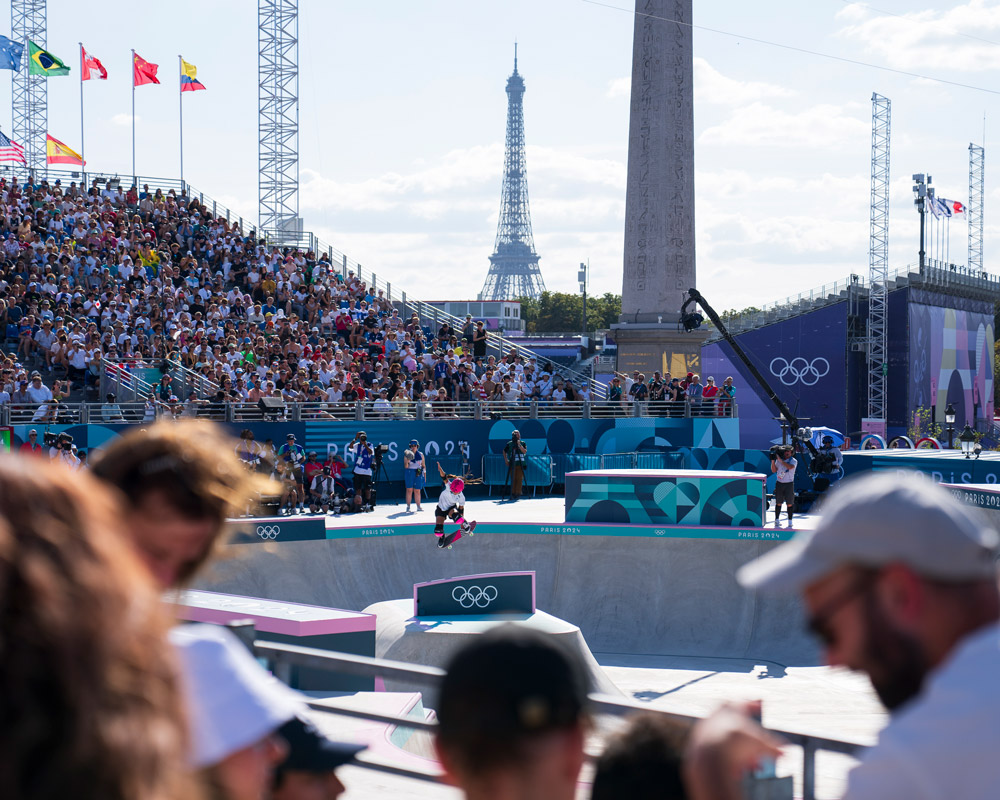
beautifully

Something that came to light in my journey to Paris was that very few single sport photographers gain accreditation for the games hence why there were, to my knowledge, no female skate photographers officially accredited. As Scott Field, director of Comms for Team GB pointed out, no one (a national sport governing body) has the luxury of having a photographer per sport. As Elsa explains, “Working as a staff photographer for a company that covers sport, it is a lot easier for me to get accreditation versus someone working as a single sport photographer. There are not as many as you’d think, they are usually working for the governing body of their sport”. For skateboarding, the governing body is World Skate. It is unclear how many photographer spots World Skate could make available. From my own knowledge, I know two of them – Atiba Jefferson and Bryce Kanights. They didn’t invite or include any of the female skate photographers I mentioned.
Atiba and Bryce were the official World Skate SB photographers for the Games. As worthy and credible photographers with bucket loads of experience, they captured the Games beautifully and through their own perspective. However, I firmly believe there should have been space created for a female photographer on that team, not only to bring equality and respect, but also a new perspective and inspired other women considering opportunities within the sport. If World Skate were to have included a female photographer, it would have demonstrated that female skate photographers are taken seriously to inspire future generations.

Myself, Raisa and Norma were all there shooting in the stands at the contest, finding every possible way to get tickets and financial support. “I couldn’t get accreditation, but I hope to be able to be there officially in the future,” explains Norma. With the generosity of a friend who works for an airline, she paid her way over from Toronto to be a part of the Games, shooting from the stands to validate her involvement in the photography community, and to prove her ability. Norma photographed the women’s street contest and also park – her shots are just incredible (as you can see below). Raisa Abal was also in the stands at both contests. Raisa is the founder of Dolores Magazine, a publishing project dedicated to female skateboarding, and has spent over a decade covering the scene and culture around the world. “I needed to be there, watching my friends skating the contest and all the new generation pushing the level higher and higher. It was a never ending hustle to get there though,” she explains.
Both Raisa and Norma were disappointed to not be accredited, but were determined to be seen by World Skate. As Raisa puts it, “We’re showing the world that we are valid and deserve to be there. I seem to not stop proving myself in front of the people involved and the industry. I know World Skate’s photography team is solid, but there’s always more space. We need representation”. The absence of female photographers, particularly those who have long championed women’s skateboarding, isn’t just a missed opportunity – it’s a reflection of systemic issues. “Representation and inclusivity is super important. The same way we want to see gender parity with athletes we need to address behind the lens and in all leadership roles for the future,” says Norma. As we look to the future, we must push for change at all levels to see it through.
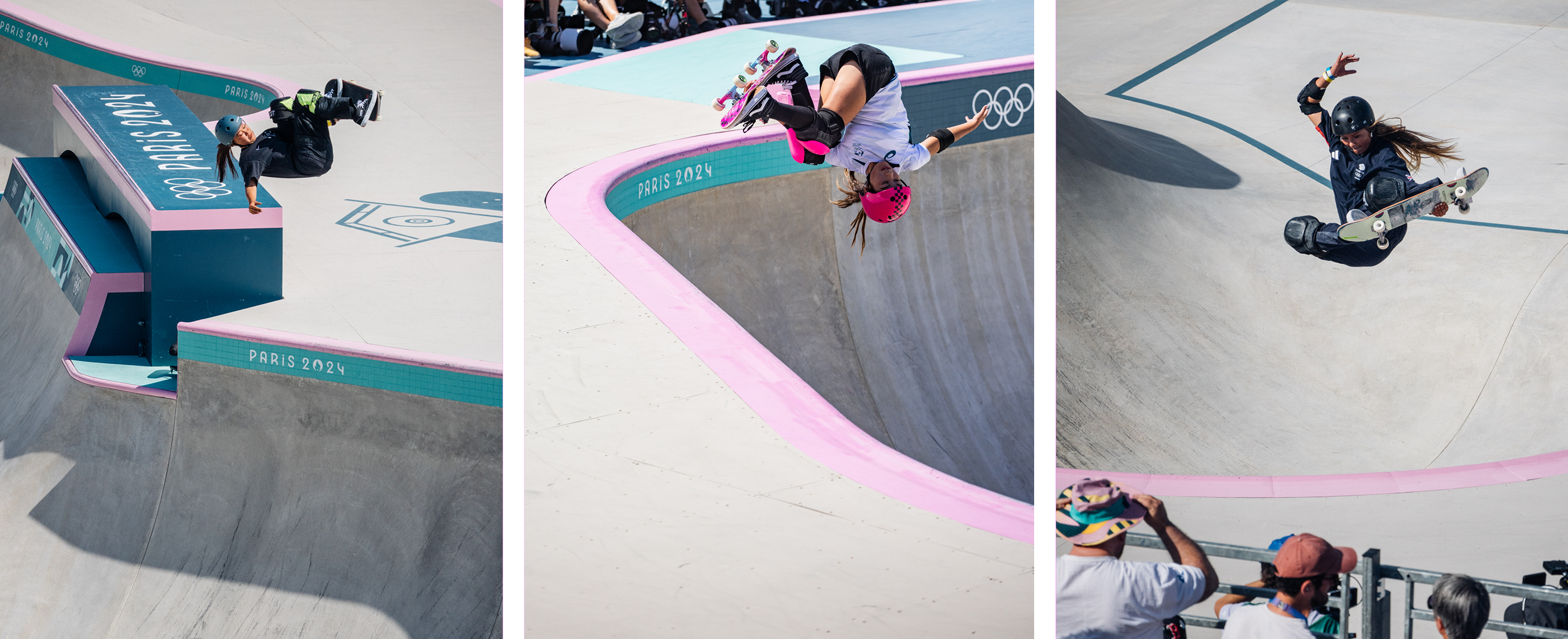
The underrepresentation of female skate photographers at the skatepark reflects broader issues in sports photography at the Games and beyond. The journey towards gender equality in sports is far from complete. While the 2024 Paris Olympics celebrated a milestone in athlete participation, the challenges for diversity behind the scenes serves as a powerful reminder of the work still ahead. If we were to go the same trajectory as athletes (with 1976 Montreal having 20% female athletes), it would take another 47 years for us to see gender-equal photographers, unless Paris reveals a drastic change! However, the IOC is making efforts towards change and addressing it as are many governing bodies. As Elsa points out, progress has been made since 2012, but there’s still a long way to go. She believes the key to change lies in increasing female representation in management and decision-making positions. “It probably doesn’t come fast enough for us that have been in it for a while” exclaims Elsa, “but you have to take a step back and realise what the field looked like when you started and what it looks like now”. She’s right. It’s amazing how much the women’s skate scene has grown in the past decade from a participation point of view, and the competitive side. Research also shows that media coverage of women’s sport in general has almost tripled in the past 5 years, so we are still seeing that wave coming through and I am sure it will take time to see the effects.
It was incredible to be there at the Games in Paris, but it does feel like skateboarding’s inclusion in the Games and popularity growth has created a gap and that female skate photographers are being left out for now. Their perspectives are worthy and important to the scene – it is valuable to include them, to invite them in to continue to be part of the scene they have supported so much. Like the IOC’s recommendations for gender-equal representation, it needs to be more than words on paper; it needs to be a call to action for governing bodies, media organisations, and the broader sports community to take action and to be excited for this change. This applies not only to photographers and media representatives, but all people and positions behind the scenes. There are lots of areas that need improvement as highlighted by Cath Bishops piece in the Guardian earlier this month. We need to address this in coaching, management and leadership positions across the board. Looking at the issue from the lens of sports photography and specifically skate photography, helps us understand that actively seeking out and nurturing female talent we can bring fresh perspectives, richer storytelling, and more nuanced portrayals of all athletes to the world stage, but also create opportunities for the future generation. Paris didn’t get us any closer for a gender balance behind the lens, but it by talking about it, and challenging current systems maybe we can see a change by 2028 and no better place to see it, in my opinion, on the side of the skatepark in Los Angeles…
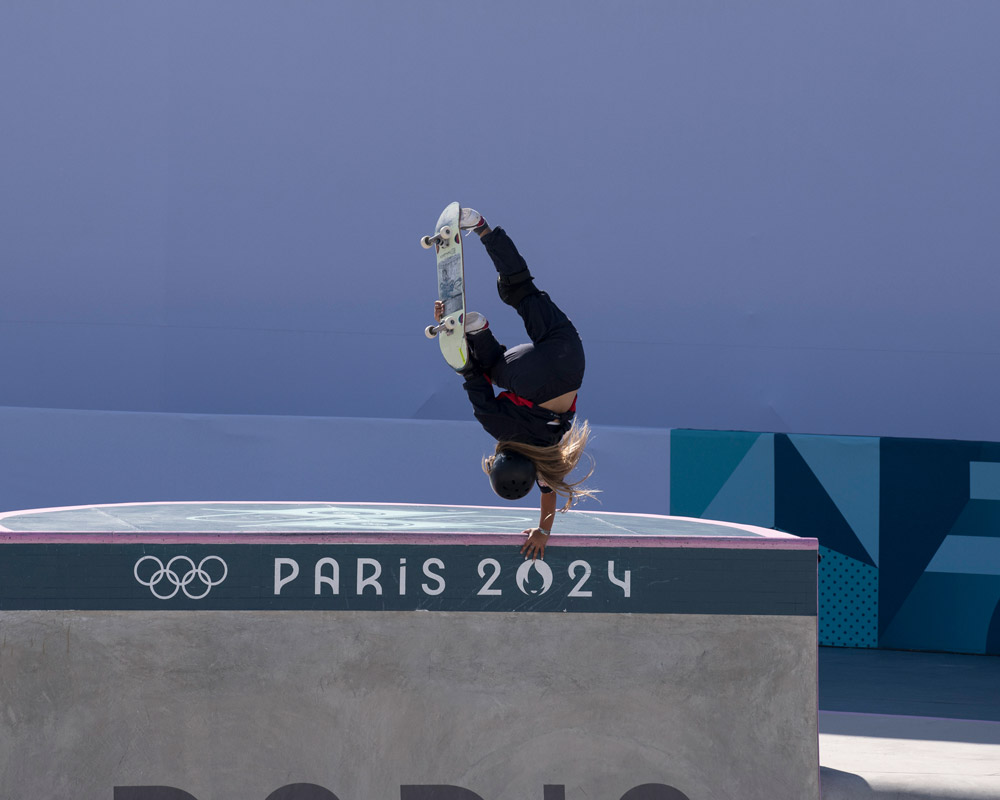
Find out more about Hannah here and keep up-to-date with Hannah on social here.
Sources: “How Paris 2024 Aims to Become the First-Ever Gender-Equal Olympics” Victoria Masterson, World Economic Forum, 2024.
“Portrayal Guidelines Gender-Equal, Fair, and Inclusive Representation in Sport” International Olympic Committee, 2024.
“Media Coverage For Women’s Sports Has Nearly Tripled In Five Years“ Forbes, 2023 via “Women’s Sports Comprise 15% of Sports Media Coverage” Wasserman, 2023.
“Women’s parity in sport has a long way to go despite positive Paris signs” Cath Bishop, The Guardian, 2024
